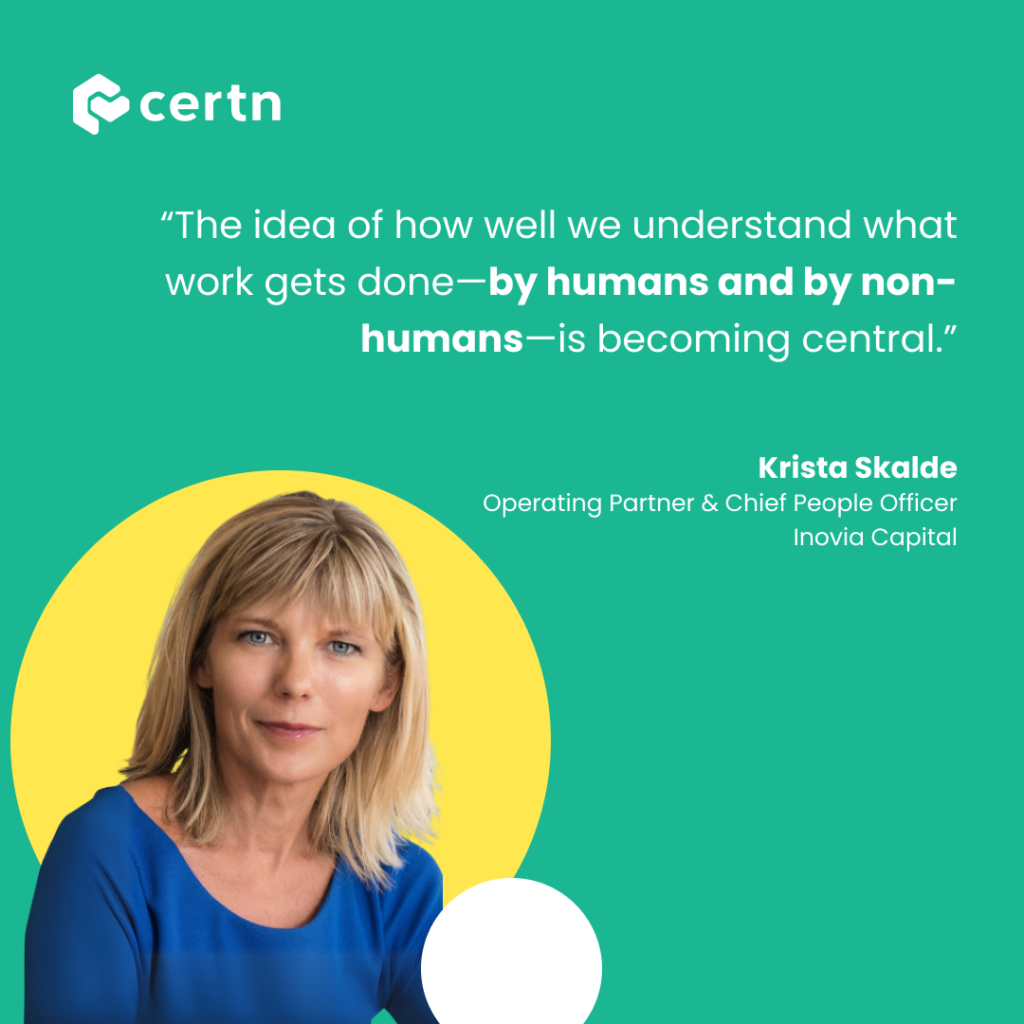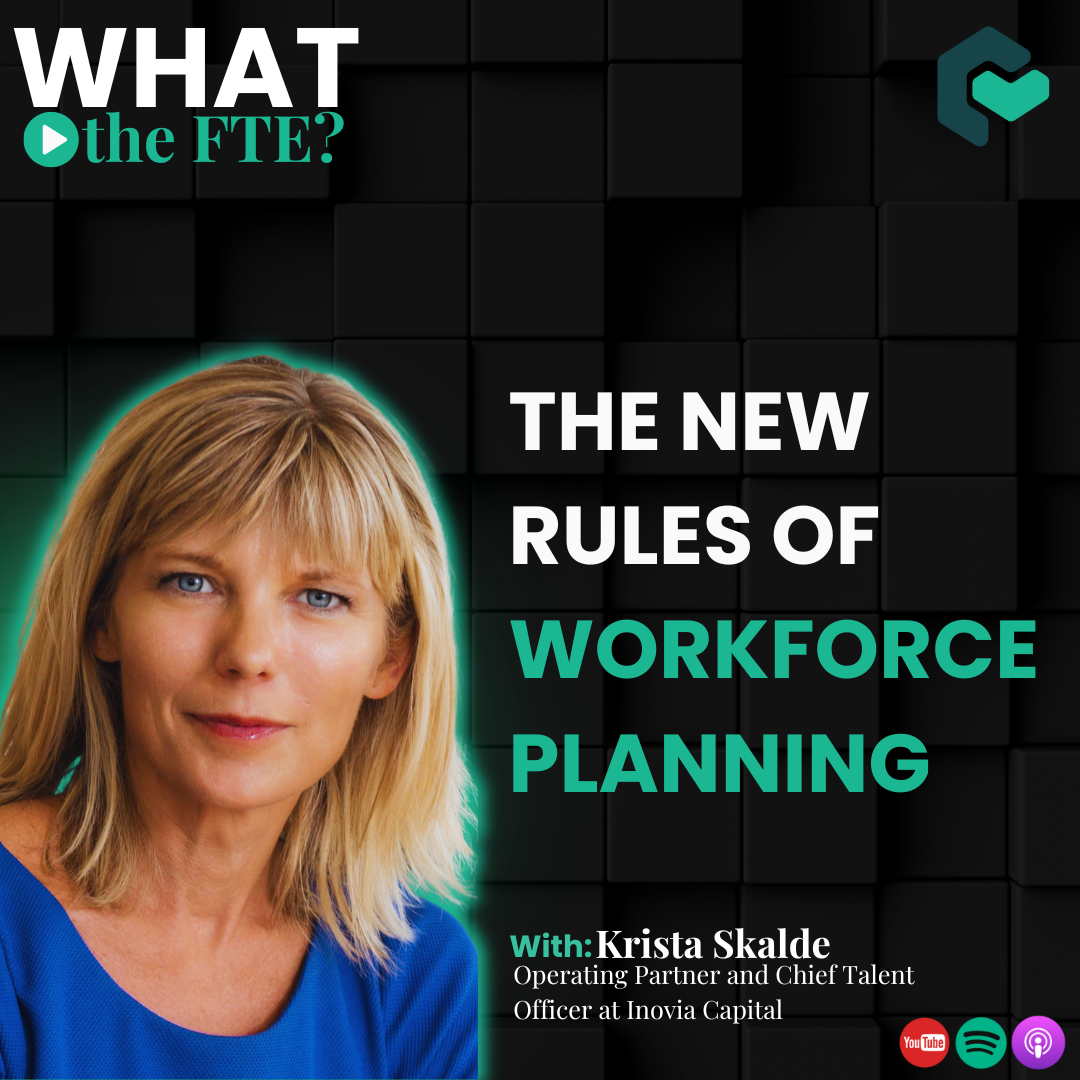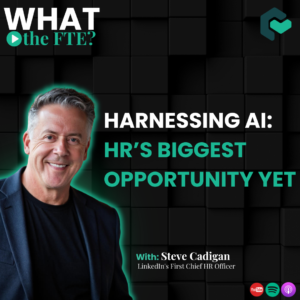What the FTE? is a podcast by Certn where we explore the tough questions surrounding the future of work, risk management, and employee experience. Whether you’re an HR leader, a TA newbie, or simply curious about the changing nature of work, this podcast provides you with practical insights to help you secure your seat at the table.
This week Certn’s CEO, Andrew McLeod, interviews Krista Skalde. Krista is an internationally recognized talent leader and future of work strategist with over two decades of experience transforming organizations through culture, capability building, and innovative workforce design. Krista has led global HR and talent functions across North America, Europe, the Middle East, and Asia, serving in executive roles in private equity, high-growth startups, and Fortune 500 companies.
A trusted advisor to CHROs, founders, and boards, Krista is known for her forward-thinking approach to leadership development, organizational agility, and the intersection of human and machine collaboration. Her expertise spans talent strategy, digital transformation, leadership coaching, and building inclusive, high-performance cultures at scale.
In 2023, Krista convened a global roundtable of HR leaders to explore the evolving role of AI in the workplace, a conversation that continues to influence how companies rethink work design, skill development, and leadership in an AI-enabled world.
—
The HR landscape is evolving, and fast. As AI moves from concept to practical application (albeit more slowly than some people predicted), HR leaders are stepping into a new kind of responsibility: leading both people and intelligent systems. Krista Skalde, a seasoned global talent executive, captures it well: “The future is now.”
In a world of job design disruption, hybrid workforces, and machine-human teaming, here’s what HR leaders need to know, and do, to stay ahead.
Human + Machine: Why HR Must Rethink How Work Gets Done

Work is no longer confined to what people alone can do. With the rise of generative AI, autonomous agents, and smart automation, organizations are being pushed to rethink not only who does the work, but also what counts as work in the first place.
Krista’s insight hits a key theme HR leaders must grapple with: Work design is no longer just about job descriptions, it’s about systems of human and machine collaboration.
This is happening faster than many expected. According to Gartner, by 2025, 40% of enterprise HR functions will have formalized roles dedicated to AI governance and machine resource management. This includes defining how AI is selected, deployed, evaluated, and how it integrates with human workflows.
Some forward-thinking organizations are already embedding AI agents directly into their org charts, signaling a dramatic shift in the role of HR from support function to strategic work architect. These AI entities are being assigned routine tasks, decision-making support functions, and even “ownership” of processes, raising new questions around role design, performance management, and accountability.
From CHRO to CHMRO: The Rise of Hybrid Leadership
As AI becomes embedded in daily operations, traditional HR leadership roles are also evolving. New titles such as Chief Human and Machine Resource Officer (CHMRO) or Chief Work Officer (CWO) are emerging. These roles don’t just oversee people strategy, they architect the human-machine dynamic. They define which parts of a role can be performed by AI, how to evaluate machine contributions, and how to design work in ways that amplify human creativity and judgment.
A similar shift is echoed in recent research from Deloitte, which finds that 65% of organizations plan to redesign roles and responsibilities in 2025 to accommodate AI-enhanced workflows. HR is now tasked with defining boundaries between human-led and AI-led work, and ensuring both operate in concert to drive value.
Strategic Imperatives for HR Leaders
Here’s what this means for People & Culture teams today:
- Reframe Work Design: This came up in my conversation with Steve Cadigan, job descriptions are no longer static. Again., echoing Steve’s sentiment, Krista adds: “This era favours curious communicators. Your ability to clearly articulate what you want from AI will determine your success.” Use tools like process maps, skill matrices, and AI-human task audits to identify how work actually gets done, and by whom. Before approving a job requisition, ask: “What part of this job must be human?” Develop a framework for human-machine role design to stay competitive.
- Build AI Literacy and Governance: Establish clear roles for managing AI within HR. Who selects the tools? Who trains them? Who ensures they align with ethical, inclusive practices? Treat AI as a thought partner. Use it to challenge assumptions, spark creativity, and co-create job descriptions, but don’t relinquish responsibility. As Krista warns, “If ChatGPT is writing your job description and you’re not refining it, you’re missing the point.”
- Think Like a Systems Designer: HR leaders must embrace a systems-thinking mindset. It’s no longer just about managing talent pipelines, it’s about orchestrating complex systems of human and machine work. AI has unlocked an unprecedented ability to dissect work into its component parts—what should be automated, augmented, or human-led. Yet, many HR teams are falling behind. A 2025 LinkedIn Workplace Trends report found that only 31% of HR teams are actively redesigning jobs to account for AI capabilities.
- Re-Skilling is a Two-Way Street: “It’s becoming a job requirement,” Krista says plainly. The expectation that organizations will upskill their workforce is valid, but employees must own their growth too. The best part? AI can teach you how to use itself. Now the thing you’re trying to learn can actually teach you. You can ask it how to be a better prompt engineer or how to write policy using your company tone. Shift L&D from course-driven to curiosity-driven. Encourage employees to use AI as a self-coaching tool. Incentivize learning through recognition and access to internal innovation projects.
- Influence the Org Chart of the Future: HR should help define how digital agents and AI tools are represented in the organization, and how they’re evaluated, maintained, and supported. This requires a new form of leadership, something I’m calling “augmented leadership,” where vulnerability, adaptability, and digital fluency meet.
Why It Matters Now
The window for HR to lead this transformation is open, but narrowing. Those who proactively design for human-machine collaboration will unlock productivity gains, talent optimization, and resilience. Those who don’t may find themselves retrofitting legacy practices onto a world that has already moved on.
According to McKinsey’s AI in the Workplace report, employees will be the ones to make their organizations AI powerhouses. Based on my experience, your team is more ready for AI than you think. They’re already using the tools, they’re open to change, and many believe AI will replace a big chunk of their workload soon. What they need now is leadership, the support, training, and vision.
From Time-Starved to Time-Smart: Creating Space for Strategic Work
With burnout rates still climbing, 60% of HR professionals reported feeling emotionally drained in 2024 (SHRM), making time for strategic thinking feels like a luxury.
Krista acknowledged this in our conversation last week: “I’ve said it myself, there’s not enough time in the day. But it’s on us to carve out that space.” Whether it’s early morning reflection or dedicated AI learning hours, it starts with discipline.
Organizations also play a role: “Do I give people space? Do I dedicate it? Do I equip them with mentors or champions who guide this transformation?”
💡 HR Action Tip: Establish internal AI mentors or “champions” whose KPI includes upskilling peers. Encourage peer learning and integrate AI exploration into performance development plans.
Final Thoughts: The Equalizer is Here
It’s come up over and over in my conversations as part of What the FTE?, AI isn’t replacing HR, it’s reshaping it. As Krista says, “If you’re not doing it, somebody else is. Your competitor will be designing better work, faster.”
In this era, AI doesn’t just change what HR does. It changes how HR thinks. The leaders who thrive will be those who lean into the ambiguity, lead with intention, and never stop learning.
The playbook is being written, page by page, prompt by prompt.
Tune into the full podcast: https://certn.co/podcast/
P.S. If you found this article helpful, share it with your team. Let’s make hiring better, together.





